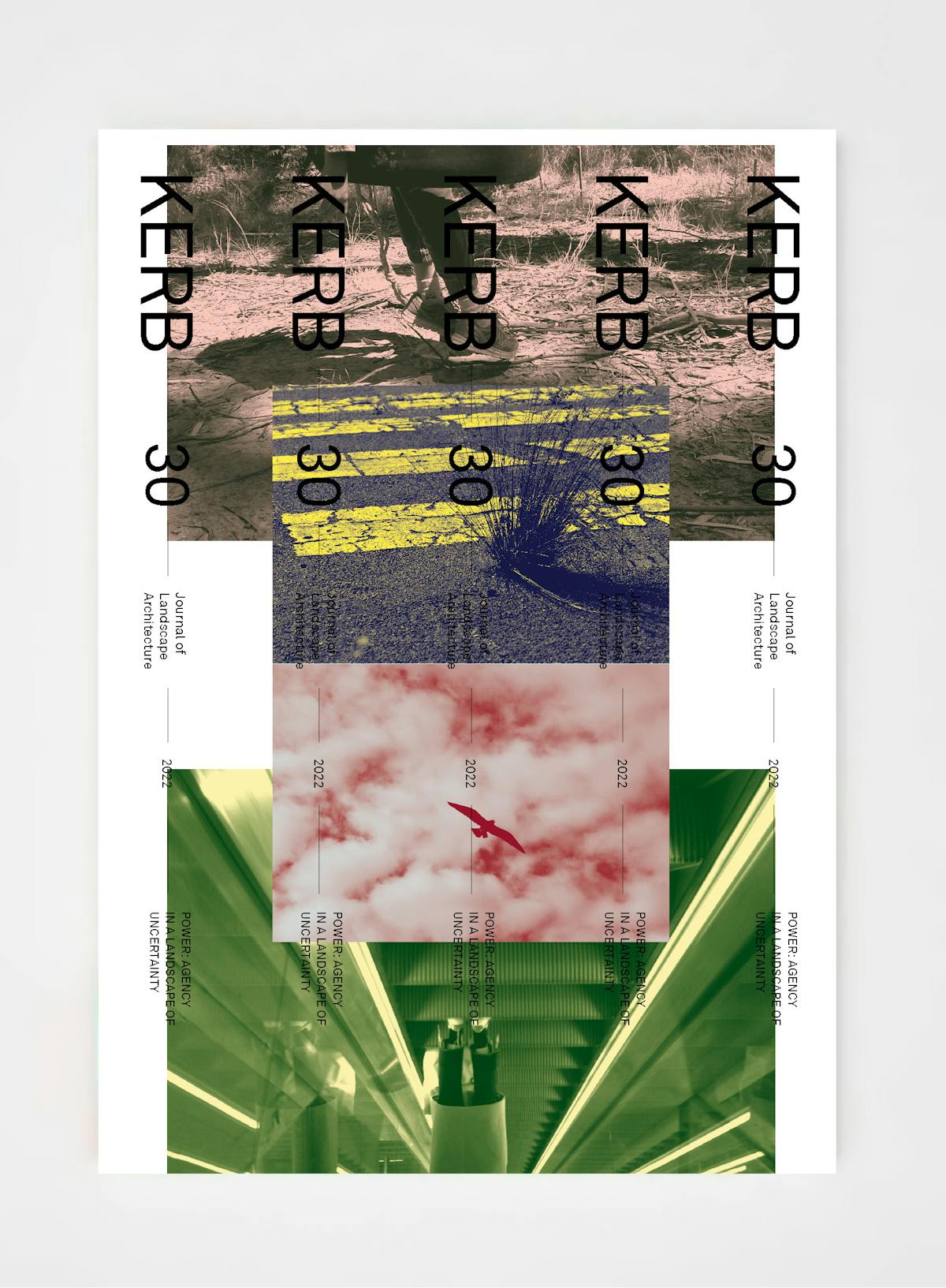EITHER an agency, a structure, a substance, nor in fact a force relation, power is a challenge. From the power puppet of primitive societies which talks but has nothing to say to the current form of power which is there only to exorcise [its very absence], a whole cycle has been covered which is one of a double challenge – the challenge of power against all of society and the challenge against those who hold power. This is the secret history of power and its catastrophe.1
Jean Baudrillard
Since its conception close to three decades ago, Kerb has charted an intrepid journey through the myriad of voices expressing the intent of the landscape architect – a message to the world: this is what we do, and this is why it’s important. In Kerb #06, published at the turn of the century, student editors outlined the ‘lament expressed in [landscape architectures] apparent lack of direction, undefined position and subordination to associated disciplines.
Nearly twenty years later, students and practitioners of landscape architecture continue traversing the journey of self-articulation. Concerned with issues up to the terrestrial scale, we are perpetually attached to finding and exploring the parameters of our own agency, seeking tangible handles to help steer our way through the haze of late-stage neoliberalism. Each Kerb periodical repositions this within a different set of rigorous parameters – decentralisation, wildness, perception – as lines of flight out of and into established practice. Therefore, it is imperative that we, as a collective of young landscape architects reign in the broad-sweeping net of the Kerb callout to reframe the collective momentum of intent firmly within the practice of landscape architecture to diversify not only the voices we champion but also the modes and directions for practical application. As students, practitioners and academics, what are the ecologies of power we navigate?
The practice of landscape architecture remains an ambiguous one. Designers capture flashes of inspiration from a moving cosmos – there are opportunities within every microcosm of the living and non-living world. Much of the ambition of contemporary practice is then dedicated to establish a clear set of operative principles within this cosmos – an arduously indefinite exercise, for such principles must, by definition, remain amorphous to retain any relevance within ecosystems of flux. The strength of this ambiguity is perhaps one of the most significant attractions of the profession. It allows the extreme flexibility of thinking but also outlines an absence of consistent and universal theoretical frameworks. So, we are joyously burdened with the privilege of power to define what our practice is, how it should operate, who it should prioritise – and reserve the right to re-establish this at any point in the journey.
After all this time, have we found any sense of collective agency? Ricky Ricardo believes there is still much work to do. In ‘The Collaboration Myth’, Ricardo reveals four possible departures from traditional practice that opens the floodgates for generative individual practice. Molly Coulter’s ‘JUST’ develops poetic polemic on the communicative tropes of gender-constructed workplace dialogue, and Lynch argues that a reframing from “landscape” to “commons” could represent a collective’ connection to action within and knowledge of land.
Up against the myriad landscape systems operating with force beyond the human/temporal framework, does the construct of “power” still hold constitutional value? Many think resistance to these forces is necessary to ensure it is so. TERREMOTO touches base with industry to drive us ‘Towards a More Collective Future’. Fleming collects a community to enforce the necessary and international implications of a Green New Deal.Goldinger and Paridy reveal the greenwashed colonialism of infrastructural projects on Indigenous land, and how the practice of landscape architecture could resist historic cultural erasure. Lukas Pauer and Emma Yi Man Tai confront the complexities of the politically charged public realm and the power of the moving landscape: ‘Wherever the Night Wolves are that should be considered Russia’. Critical of the impacts of extractivist politics around the globe, Kyle Bush runs interference, highlighting extraction landscapes as ‘a spatial register of the hegemonic extractivist logic underpinning global cultures of power’.
Surrender to the ASMR reading of AHORA’s ‘Whisper’. Take a selfie with Bonnie Lester in ‘The Power of the Face’. De-territorialise with Efrat Hildesheim in the ‘Dialectics of the Gardens to Go’. And listen in on a conversation between editor Sam Cannon and lauded artist/architect Jorge Otero-Pailos about carving your own path and reframing the filthiness of anthropocentric impact.
Power is a challenge. To acknowledge power is to claim, to define and to reveal it. With this on the mind, Kerb#30 was constructed with the intention to challenge (within the physical limitations of a printed publication) the perceptions of power held by the collective to reveal moments of agency discovered through experimental and exploratory practice and to chart the complex array of novel relationships we are developing between our agency and the forces we negotiate. In acknowledging this, we must also be conscious of our accountability with the power we hold as an editorial body. We make a direct claim to the voice of the industry as we discuss the nuances of professional engagement in the landscape, office and studio. This is a “powerful” connotation of ownership, licence and control, and the more we dive into practice, the more we realise how much power we really have. It is observed in the small gestures of celebration, in noticing the unnoticed, and in lending voice to the non-human. It is in the language of our emails, conversations and manifestos. It is a gesture of faith in what we do, and the possibilities of what could be done – held tightly by the collective and offered to you, the individual, within this journal.
Footnotes
-
J. Baudrillard, ‘Forget Foucault’ Semiotext(e) Foreign Agents Series, Semiotext(e), 2007, p.59 ↩
